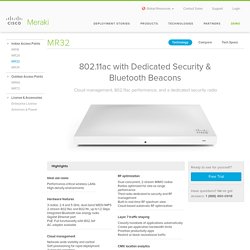

Week 2 Configuring a 2900 WLAN integrated controller rewrite 2. Wireless LAN Controller. Cisco Aironet 3700 Series access points surpass the competition in Miercom tests.
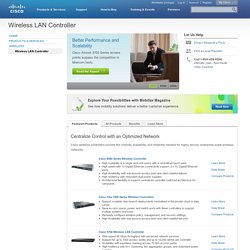
Read the Report Cisco wireless controllers offer a wide range of benefits to businesses of all sizes. Wireless LAN Controller Module (WLCM) Configuration Examples. Introduction The Cisco WLAN Controller (WLC) module (WLCM) enables Cisco ISRs and Cisco 3700 Series Routers to manage up to six wireless LAN (WLAN) access points (APs) and simplifies the deployment and management WLANs.
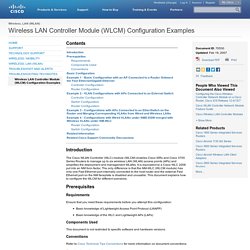
It is equivalent to a Cisco WLC 2006 put into an NM form factor. The only difference is that the NM-WLC (WLCM module) has only one Fast Ethernet port internally connected to the host router and the external Fast Ethernet port on the NM faceplate is disabled and unusable. This document explains how to configure the WLCM for different scenarios. Prerequisites. Cisco 3900 Series, 2900 Series, and 1900 Series Software Configuration Guide - Configuring the Wireless Device [Cisco 1900 Series Integrated Services Routers] Starting a Wireless Configuration Session Enter the following commands in global configuration mode on the router’s Cisco IOS command-line interface (CLI). interface wlan-ap0 ip address subnet mask no shut interface vlan1.
![Cisco 3900 Series, 2900 Series, and 1900 Series Software Configuration Guide - Configuring the Wireless Device [Cisco 1900 Series Integrated Services Routers]](http://cdn.pearltrees.com/s/pic/th/configuration-configuring-105367635)
How to: Conduct a Wireless Site Survey. Back to Tutorials With wireless systems, it’s very difficult to predict the propagation of radio waves and detect the presence of interfering signals without the use of test equipment.
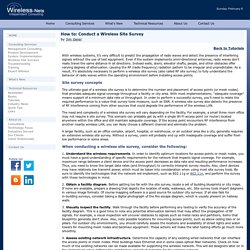
Even if the system implements omni-directional antennas, radio waves don’t really travel the same distance in all directions. Instead walls, doors, elevator shafts, people, and other obstacles offer varying degrees of attenuation, causing the RF (radio frequency) radiation pattern to be irregular and unpredictable. As a result, it’s absolutely necessary to perform a wireless site survey (also called RF site survey) to fully understand the behavior of radio waves within the operating environment before installing access points. The benefits of integrated access point beacon technology « Cisco Meraki Blog.
Cisco Meraki customers can easily future proof their networks for the needs of their business with the new Meraki MR32 and MR72 802.11ac access points (AP) that include built-in Bluetooth Low Energy (BLE) beacon technology.

These APs can be integrated seamlessly into any standard WLAN deployment, while giving customers a BLE beacon-enabled network, ready for the future. We see this being especially important in retail where iBeacons and other customer Bluetooth engagement technologies are rapidly growing in adoption. What are BLE Beacons? Introducing New 802.11ac Access Points with Beacons « Cisco Meraki Blog. We are very excited to introduce two new wireless access points, the Cisco Meraki MR32 and MR72.
They are dual–band, 2×2 802.11ac APs and include integrated Beacon (Bluetooth Low Energy) technology. Beacons enhance location capabilities and enable more active customer engagement, such as with iBeacons, and with the MR32 and MR72 there’s no need to deploy dedicated iBeacon hardware. The new APs also include the rich, cloud-managed feature set common to the entire Meraki wireless portfolio and feature the dedicated security radio technology found in other Meraki APs.
Six steps to a wireless site survey. To get the best performance out of your wireless network, you must both ensure that your access points (AP) are in the most optimal locations and that other radio emitters, which can cause interference, are kept to a minimum.
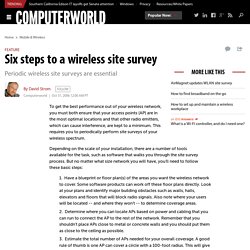
This requires you to periodically perform site surveys of your wireless spectrum. Depending on the scale of your installation, there are a number of tools available for the task, such as software that walks you through the site survey process. But no matter what size network you will have, you'll need to follow these basic steps: Have a blueprint or floor plan(s) of the areas you want the wireless network to cover.
Figuring out wireless transmission distance. When planning or updating a wireless LAN installation, it's often necessary to determine if your wireless equipment can achieve a certain transmission distance.
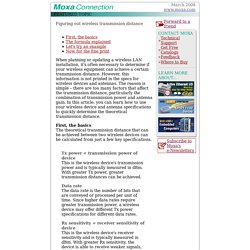
However, this information is not printed in the specs for wireless devices and antennas. The reason is simple – there are too many factors that affect the transmission distance, particularly the combination of transmission power and antenna gain. In this article, you can learn how to use your wireless device and antenna specifications to quickly determine the theoretical transmission distance. First, the basics The theoretical transmission distance that can be achieved between two wireless devices can be calculated from just a few key specifications. What is user self-provisioning ? - Definition from WhatIs.com. User self-provisioning, also known as cloud self-service, is a system that allows end users to set up and launch applications and services in a cloud computing environment without the direct intervention of an IT organization or a service provider.
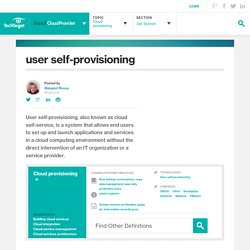
User self-provisioning can be used in public, private and hybrid cloud scenarios. In many public clouds, user self-provisioning can take place over the Internet using web applications or services provided by a third-party provider partnering with the cloud provider, or the cloud provider may have its own back-end system for self-provisioning. Meraki_datasheet_mr.pdf. Cisco Meraki Cloud Managed Wireless Products. Highlights Ideal use cases Performance-critical wireless LANs High-density environments Hardware features.
